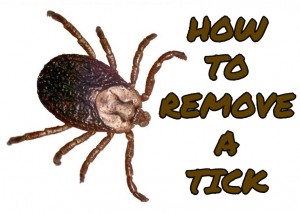 Ticks are everywhere this time of year in East Tennessee. If you are like us then you like to get outside and that puts you at some risk to have one of these nasty little parasites chomp your skin in and suck your blood. You can try to prevent them all you want, but inevitably they will get onto your pets, children, spouse, or you and then you are stuck with the task of removing a tick.
Ticks are everywhere this time of year in East Tennessee. If you are like us then you like to get outside and that puts you at some risk to have one of these nasty little parasites chomp your skin in and suck your blood. You can try to prevent them all you want, but inevitably they will get onto your pets, children, spouse, or you and then you are stuck with the task of removing a tick.
Growing up I remember there being a host of methods suggested to removing a tick. You can slather them with petroleum jelly, the common thinking is that they would be suffocating in the jelly and back their way out of your skin. There was the burn them with a hot match (which you just blew out the flame), the idea being that they’d go running for cover when scorched. Trouble with these methods, for me, is that they never worked or took too long. Last thing anyone wants is to see these tick parasites attached to your skin.
How to Remove a Tick
The quickest and most thorough way to remove a tick off is to physically remove it and not dance around with some other fancy techniques. A big key when removing ticks, you will hear this from just about every expert, is to be sure to remove the ‘head’ of the tick, which is embedded into your skin. If a tick has just bitten onto you or loved one then the tick is not embedded as deeply and removing the head will probably just come out with the rest of the body. Regardless, be sure you are doing these steps well in order to rid yourself of the tick for good.
- Determine that this is a tick. Some ticks can be so tiny they might be confused for a skin mole. If you think it is a tick just rub or jab at the spot and look for its gross parasite legs to start to squirm. If you see that, then you have a tick. Some people might confuse chiggers with ticks. Hate chiggers as well, but they are way smaller than ticks and need to be treated differently.
- Get a fine tipped tweezers and pinch as close to the skin as possible. I like to get one tip point underneath the body of the tick with the other tip on the topside of the tick. This is just my thinking that it’s easier to remove the tick this way because they are flatter from side to side and you can grip more surface area. If you are going camping then make sure to put some tweezers in a first aid kit or make-up pack. If you are out and about without tweezers (and can’t stop a Walgreens at the next corner) then you can attempt to remove the tick with some sharp fingernails. Yes, this can work, it just is not ideal.
- Lift upward on the tick, do not twist, jerk or pull unevenly on the tick. Getting anxious trying to remove a tick can result in tearing the tick and leaving that head embedded in the skin. If you do pull out the tick and the head is in the skin then use those tweezers to finish removing the tick head. This might be tedious, similar to removing a splinter. Take the tick and flush that nasty little parasite down the toilet. They are pretty indestructible, so putting them in the trash might only result in them showing up again on your family.
- When you are satisfied that you have thoroughly removed the tick then treat the bite mark with alcohol wipes or peroxide to kill off any infectious bacteria that might be present. If those types of items are not present to clean a bite spot then thoroughly wash with soap and water. You should be fine after that and the skin should heal in a week or so.
- If you notice a rash emanate from bite mark or begin to have fever spells then get to a doctor quickly. You may showing symptoms of tickborne illnesses such as Lyme Disease or Rocky Mountain Spotted Fever (not to be taken lightly).
When it comes to pets, dogs especially, removing ticks can be difficult. All that hair can be a real issue. If you are regularly brushing your dog with a flea and tick comb then you will keep ticks from really embedding into your pets skin which will make removal (using the same process) much easier and more effective.
If you want to know everything else there is to know about ticks then you can check out the Center for Disease Control’s website page dedicated to ticks.